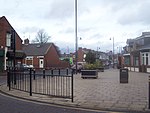Southwick, Sunderland
Southwick is a former village and now a suburb on the north banks of the River Wear in the city of Sunderland in the county of Tyne and Wear, historically in County Durham. From 1894 to 1928, Southwick was administered by the Southwick-on-Wear Urban District Council, before being absorbed by Sunderland. Southwick borders with Castletown and Hylton Red House to the west, Monkwearmouth to the east, greenbelt farmland and the suburb of Carley Hill to the north, and the Wear to the south although the Queen Alexandra Bridge links Southwick to Pallion and central Sunderland. It is home to a police station that services the north of Sunderland. There is a primary school, but no secondary school. Sunderland A.F.C.'s Stadium of Light is visible to the east on the Monkwearmouth side. Southwick is centered on its village green, a commercial area containing three listed buildings; a World War II war memorial, The Tramcar Inn a public house built in 1906, and a memorial lamp-post built in 1912. [1] According to Indices of Deprivation published by the Department of the Environment, Transport and the Regions in 2000, Southwick is the most deprived of the 25 wards in Sunderland, the fifth most deprived in Tyne and Wear, and the fifty-fifth in England. [2].
Excerpt from the Wikipedia article Southwick, Sunderland (License: CC BY-SA 3.0, Authors).Southwick, Sunderland
Church Bank, Sunderland Marley Pots
Geographical coordinates (GPS) Address Nearby Places Show on map
Geographical coordinates (GPS)
| Latitude | Longitude |
|---|---|
| N 54.919349 ° | E -1.406192 ° |
Address
Church Bank
Church Bank
SR5 2DY Sunderland, Marley Pots
England, United Kingdom
Open on Google Maps






